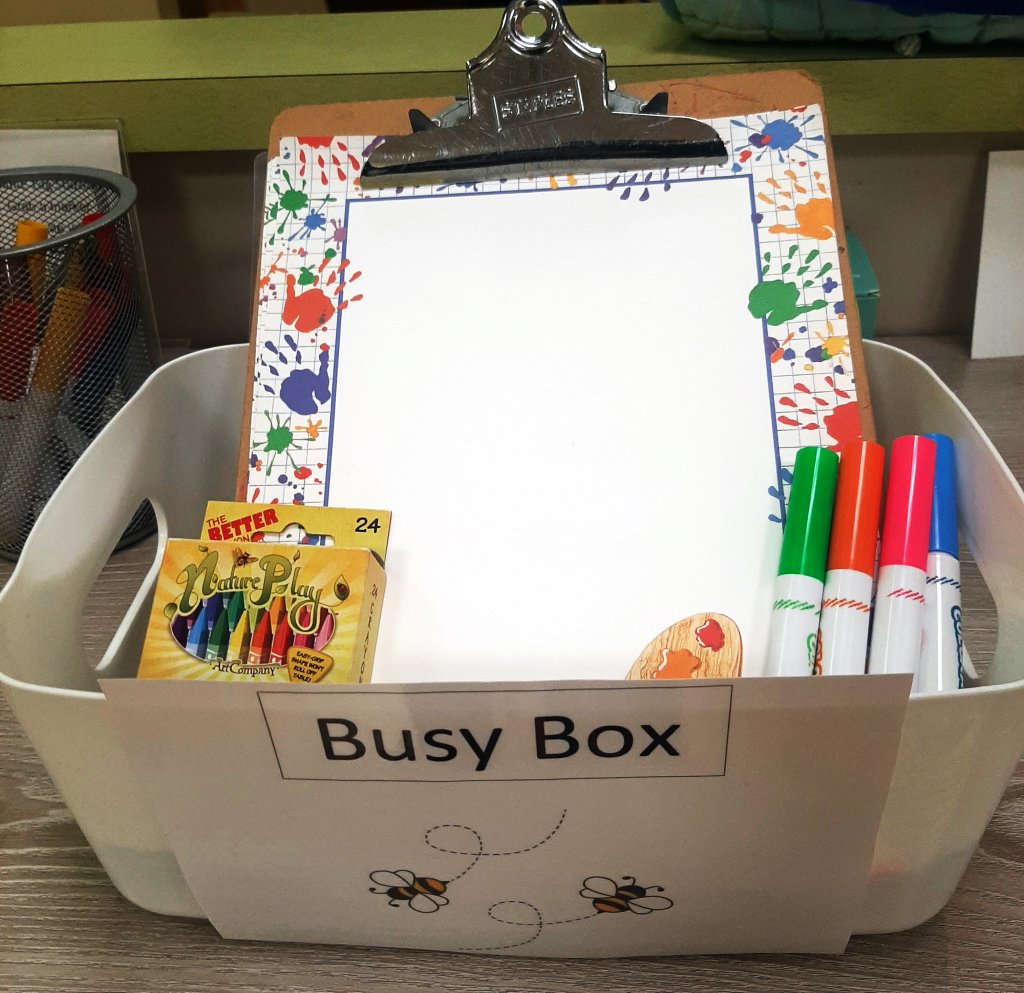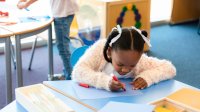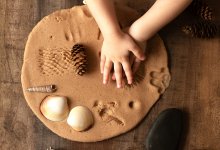Building Busy Boxes for Preschoolers
These kits—organized around lessons or students’ individual interests—encourage preschoolers to engage in independent play.
The best part of being in a preschool classroom is the energy and curiosity that young children bring to their daily activities. They thrive on exploring their environment, but there are times when children need quiet to focus their minds and calm their bodies.
My school’s preschool curriculum has recently shifted from having nap time after lunch to promoting rest time. We have a mixed-age classroom with children who are 3 and 4, and we’ve found that the younger preschoolers often still require a nap, while the older ones do not.
Moving the children who are awake to a different classroom isn’t always an option, so it has been challenging to meet the needs of everyone in our care. I’ve begun using busy boxes to keep the children who don’t nap from disturbing the ones who do, but their use is not limited to rest time. Students can pull out their busy boxes to start or end their day, during transitions, or when moments of quiet and self-regulation are needed. Preschoolers often experience big emotions throughout their day, and it is important for them to have opportunities to play by themselves.
What are Busy Boxes?
Busy boxes are containers that are filled with age-appropriate materials meant to engage preschoolers and promote independence. It is important to have enough boxes so that children do not have to share. The busy boxes can be made using baskets, plastic containers, shoeboxes, or tote bags. They should be small enough for children to carry themselves. I’ve selected boxes that fit in our preexisting cubbies to make storage easier. After you’ve decided what to put in the busy boxes, it takes only minutes to put them together. Rotating the boxes that children have access to also keeps their interest level high.

When introducing busy boxes to preschoolers, it’s important to set expectations and to model how to use them appropriately. Preschoolers are still expected to use the materials respectfully (e.g., crayons don’t go in their mouths, and book pages should not be ripped or drawn on) and to clean up after themselves.
Tailoring the boxes to children’s interests and rotating materials can prolong the excitement over busy boxes, but it is necessary to engage in a cycle of assessment and reflection to ensure that you are getting the most out of the busy boxes in your classroom.
Ideas for Preschool Busy Boxes
Center-based boxes. There are many different ways to build your busy boxes. One method of organization is creating a busy box for each learning center. With this strategy, children can select a box based on their individual interests.
- Art: In this box, I would include paper, crayons, colored pencils, stickers, markers, a clipboard, art books for inspiration, picture-based art prompts. I wouldn’t include coloring books or scissors. We focus on process-oriented art, and coloring books don’t allow young children to think creatively. Scissors, even safety scissors, should be used only when children are sitting at a table and being supervised by adults.
- STEM: In this box, I would include fidget toys, puzzles, small animal figurines, foam shapes, plastic links, nesting toys, and number flash cards. I wouldn’t include heavy blocks or Legos. These items make noise when children are sorting them, and block structures can fall down and scatter everywhere. Small pieces can also be hard to see in dim lighting, and they take a while to clean up.
- Language arts and dramatic play: In this box, I would include picture books, audio books with headphones, finger puppets, felt storyboard and characters, recipe cards, and dollhouse figurines. I wouldn’t include books that are too word-heavy and require adult direction. If a child would ask you to read the book to them, don’t include it.
Project-based busy boxes. Busy boxes can also serve as more structured learning provocations that invite children to make observations about their environment and to develop problem-solving skills.
During a unit on the solar system, for example, you could create a busy box that asks children to make a visual representation of the surface of the moon. Materials in the box would still be open-ended (paper, crayons, rocks, pictures of craters, cloud dough, etc.), but children would have a set task to complete and prior knowledge of the concept, which may minimize frustration.
The advantage of this organization strategy is that classroom learning is being reinforced and expanded on to create an even deeper understanding. Children can share their creations after rest time, and their engagement with the materials can help determine what items should be added or removed to further scaffold their learning. If a child is struggling with solar system terminology, you might preteach certain words before introducing the busy box. Or, you may find that including pictures of the moon stifles student creativity.
Individualized busy boxes. One way to increase excitement for busy boxes is to have your preschoolers design, decorate, and fill their boxes with materials, activities, and books that are highly appealing to them. If you use this method, I would remind your preschoolers that the items they select are meant to be used independently and without teacher assistance.
After children have used their boxes for a week or two, give them the option to swap materials so that the items in their busy boxes continue to reflect current interests and meet their developmental skill levels.
Benefits of Busy Boxes
The biggest benefit of using busy boxes is the reduction of power struggles between teachers who want children to maintain a quiet atmosphere for rest and students who want to keep playing and engaging their minds while classmates are sleeping.
All preschoolers should still be given the opportunity to relax their bodies because rest is crucial for brain development, but that doesn’t mean children who don’t nap have to sit quietly on mats until their friends are awake and rest time is over.
When you give children busy boxes, you are not only providing a form of entertainment to prevent boredom—you are also offering each child the ability to make their own choices, to embrace mistakes through trial and error, and to build self-regulation skills through independent play.

